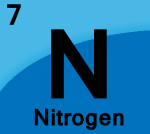
Nitrogen is essential to life on Earth. It is a component of all proteins, and it can be found in all living systems. Nitrogen compounds are present in organic materials, foods, fertilizers, explosives and poisons.

Nitrogen Cycle
The nitrogen cycle, in which atmospheric nitrogen is converted into different organic compounds, is a crucial natural processes to sustain living organisms.
During the cycle, bacteria in the soil process atmospheric nitrogen into ammonia, which plants need in order to grow. Other bacteria's convert the ammonia into amino acids
and proteins. Animals then eat the plants and consume the protein. Nitrogen compounds return to the soil through animal waste. Bacteria then converts the waste nitrogen back to
nitrogen gas, which returns to the atmosphere.
Nitrogen (N)
Please feel free to Add a Listing to buy or sell
Nitrogen Gas
At standard temperature and pressure, two atoms of the element bind to form dinitrogen, a colourless and odorless Diatomic Gas (N2).
N2 constitutes about 78% of Earth's atmosphere.
Liquid Nitrogen (LN2)
Please feel free to Add a Listing to buy or sell
Liquid Nitrogen
Liquid nitrogen is the liquefied form of the element nitrogen that's produced commercially by the fractional distillation of liquid air.
In its liquid form nitrogen is also colorless and odorless and looks similar to water.
Liquid nitrogen has many uses, because of its cold temperature, such as quick freezing, cryopreservation, a coolant for superconductors and the
cooling of materials for easier machining or
cryogenic fracturing.
Liquid nitrogen is stored in special insulated containers that are vented to prevent pressure buildup.
Ammonia
Please feel free to Add a Listing to buy or sell
Ammonia
At room temperature, Ammonia (NH3), a compound of nitrogen and hydrogen is a colorless, highly irritating gas with a pungent,
suffocating odor.
Ammonia gas is easily compressed and forms a clear liquid under pressure.
In the environment, ammonia is part of the
nitrogen cycle
and is produced in soil from bacterial processes.
Ammonia is also produced naturally from decomposition of organic matter, including plants, animals and animal wastes.
A large percentage of the ammonia produced is used in
fertilizer.
It is also used as a refrigerant gas, for purification of water supplies, in household cleaning
products and in the manufacture of plastics, textiles, pesticides, dyes and other chemicals.
Ammonia also is used in the waste and wastewater treatment, cold storage, rubber, pulp and paper and
food and beverage industries as a stabilizer,
neutralizer and a source of nitrogen. It also is used in the manufacture of pharmaceuticals.



Blue Ammonia
Blue ammonia is made from
hydrogen, called a blue fuel because the carbon emissions from the conversion process are captured.
Turning hydrogen into ammonia allows it to be shipped more easily.
Blue ammonia is a feedstock for
blue hydrogen, a version of the fuel made from fossil fuels with a process that captures and stores
C02 emissions.
Green Ammonia
Green ammonia production is where the process of making ammonia is 100% renewable and carbon-free.
One process of making green ammonia is by using hydrogen from water electrolysis and nitrogen separated from the air.
Green ammonia is intended to be used in the production of carbon-neutral fertilizer products, decarbonising the food value chain,
and also has potential as a future climate-neutral fuel.
Green ammonia production makes use of renewable energy sources such as hydro-electric,
solar power
or
wind turbines.
Turquoise Ammonia
Turquoise ammonia is produced using
pyrolysis
to convert
methane
into pure carbon and hydrogen, which is reacted with nitrogen to make ammonia.
Nitrogen Fertilizer
Please feel free to Add a Listing to buy or sell
Nitrogen Fertilizer
Nitrogen fertilizers are made from
ammonia (NH3)
produced by the Haber-Bosch process. In this energy-intensive process, natural gas (CH4) usually supplies the hydrogen, and the
nitrogen (N2) is derived from the air. This ammonia is used as a feedstock for all other nitrogen fertilizers,
such as anhydrous ammonium nitrate and
urea.
Nitrate Cycle
One approach in a circular material recovery cycle is a nitrate loop, which may save on the
thermal energy requirements in the regenerative steps.
A sequence of carbonate, nitrate, hydroxide stages may be an effective method of
CO2
collection and concentration.
Using a hydroxide media as a
sorbant
to accumulate dilute CO2 from ambient air or exhaust streams may act as a semi passive sponge.
The hydroxide combines with the CO2 to form a carbonate and as the carbonate media becomes saturated,
a concentrated stream of CO2 may be retrieved when reacted with
Nitric Acid.
This reaction forms a nitrate, when the nitrate is mixed with water (H2O) it forms a hydroxide and the solid, dry
hydroxide is recovered and is ready to enter the regenerative loop once again.
In other recovery applications, the formation of metal nitrate solutions may be an effective method for the
selective extraction in a direct displacement
Hydrometallurgical
refining process.
